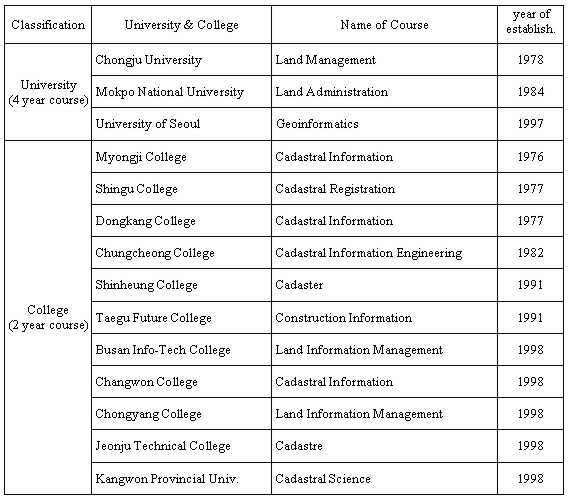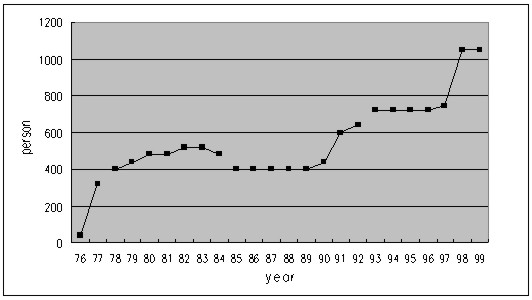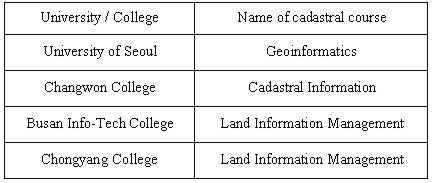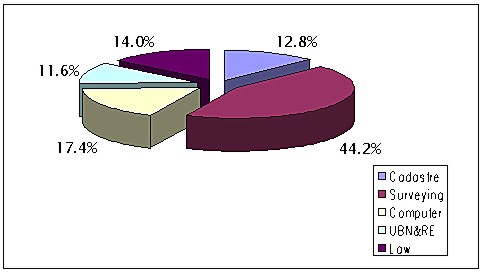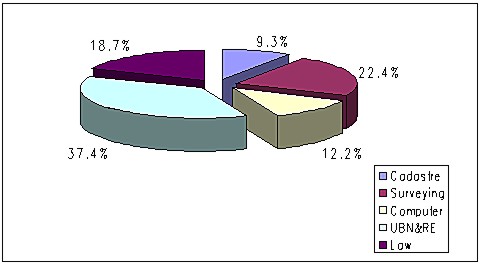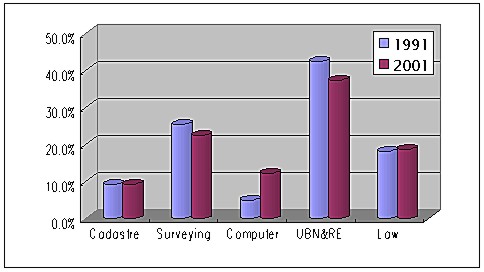THE DEVELOPMENT AND CHARACTERISTICS OF THE MODERN CADASTRAL EDUCATION IN KOREAJongduck JI and Hwanzong YU, KoreaKey words: cadastral education, cadastral course, curriculum, computerization. 1. INTRODUCTIONThe cadastral education in Korea has developed as the education and training of special purpose from the national land management point of view. So, the goal and growth of cadastral education have been closely related to the cadastral development plans and demands of the government authorities (Kang, 1999). The modern cadastral education has been begun from the Old Korean Empire, and the regular surveying training has been extended so as to bring up cadastral technician for the execution of the National Land and Forest Surveying Project in the early 20th century. The Korea Cadastral Association, which was established in 1938 and has been developed to the present Korea Cadastral Survey Corporation, has been in charge of the training and education of its staffs and civil servants in cadastral posts (Ryu, 2000). Since the 1970's, the national affairs of cadastre and the demand of cadastral experts have been increased, so the cadastral courses have been opened at high-level educational institutes with the active support of the Ministry of Government Administration and Home Affairs. The two-year course of cadastre was firstly established in Myongji College in 1976. The field of cadastral education has been developed rapidly both in quantity and quality. Nowadays, the professional theories and technical practices on cadastre are educated in 11 two-year colleges and 4 universities. But the change of cadastral system has affected the educational goal and curricular of cadastral course. The recent changes of cadastral affairs and system are accompanied with the reformation of cadastral education, too. For the purpose of preparing for the national projects such as the computerization of cadastral affairs, the cadastral resurveying project and the construction of Parcel-Based Land Information System (PBLIS), each department of cadastre has changed its name, educational section, educational program and curriculum. In these processes, the differences are appeared between colleges and universities. This paper intends to investigate the development and characteristics of the modern cadastral education in Korea, in relation to the change of cadastral systems. Also, this paper includes the in-depth analysis on the characteristics and differences of the cadastral courses in colleges and universities. In this part, Myongji College and Chongju University are selected in order to make a comparative analysis between college and university for the period 1991-2001. 2. HISTORY AND BACKGROUND OF CADASTRAL EDUCATIONIt was the first modern cadastral education that the field surveying was trained by foreign technician to prepare for the National Land Surveying Project in the Old Korean Empire. Under the rule of Japanese Imperialism, the surveying engineers were brought up in the public and private technical school (including agricultural and forestry school) to execute the National Land Surveying project(1910-1918) and the National Forest Surveying project(1916-1924). The Cho-Sun (Korea) Cadastral Association was established in 1938, so as to perform the cadastral surveying in place of the government and to produce cadastral surveyors continuously (Cho and Kim, 1995; Ryu, 2000). In those days, the modern cadastral education was set up. From 1945 to the mid 1960's, the cadastral affairs such as the initial registration of the lands excluded in the former surveying projects, the recovery of land register lost by Korean War, registration conversion surveying, and so forth were increased and extended. So the Korea Cadastral Survey Corporation operated the short-term training and re-education courses for the purpose of meeting the demand of cadastral technicians (Ji, 2000). Since the 1970's, the rapid industrialization and urbanization have increased the demand of land-use. The various land development projects such as urban and farmland readjustment, housing land development, urban renewal, industrial district development etc. were carried out vigorously. As a result, the demand of cadastral affairs increased rapidly. That was also required to improve the accuracy and efficiency of cadastral surveying and administrative affairs, and to upgrade the quality of cadastral technicians. So the training activities of the Korea Cadastral Survey Corporation have been intensified, and the departments of cadastre have been established in colleges and universities. They have offered two-year course at colleges and four-year course at universities in order to produce the cadastral technicians and experts systematically and continuously. 3. DEVELOPMENT OF MODERN CADASTRAL EDUCATIONIt was a turning point of the modern cadastral education in the 1970's. The core of cadastral education was transferred from short-term technical training to college and university education according to the social and economic development and the requirement to provide theoretical base and practical experts for the efficient land and cadastral management. Moreover, the Ministry of Government Administration and Home Affairs and the Ministry of Construction pointed out the deficiency of cadastral manpower and requested that the cadastral course should be established in university. In 1973, prior to the establishment of cadastral course in university, a lecture on cadastral surveying was opened in the College of Agriculture of Konkuk University (Kang, 1999). The independent department on cadastre was first established in Myongji College in 1976. Subsequently, the cadastral courses were also offered in Shingu College and Dongkang College in 1977. The four-year cadastral course was established in Chongju University in 1978. The name of the course was Land Management, which was more comprehensive than cadastre. The departments of cadastre in the universities and colleges are shown in Table 1.
Table 1. Departments of cadastre in the universities and colleges The nationwide land speculation and the rapid rise of land prices had many concerns for land and real estates in the late 1980's. These led to the increase of cadastral affairs and the demand of cadastral manpower in succession. The departments of cadastre were established in Shinheung College and Taegu Future College in 1991. And the number of students in existing departments was increased. Since the mid 1990's, the transformation of cadastral system and its environment has been appeared, that is the computerization of cadastral affairs, the construction of land information system, the introduction of advanced equipment and the preparation of the national land resurveying project. These changes have affected cadastral education. So new cadastral courses have been established in University of Seoul and many provincial colleges. Figure 1 shows this quantitative growth of cadastral education since 1976.
Figure 1. The increase of student quota in cadastral courses by the year. 4. THE CHANGING CHARACTERISTICS OF CADASTRAL COURSE4.1 Name and educational section of cadastral courseThe developmental directions of cadastre propelled by the government authorities are the computerization of cadastral affairs, the national land resurveying project, the cadastral surveying using GPS, the creation of cadastral system based on LIS, the cadastral surveying project of north Korea after unification etc. The goal and program of cadastral education have been conformed to these directions, too. So the departments of cadastre in colleges and universities have been reformed to the practical course using advanced equipment and facilities in order to bring up the cadastral experts to play an important role in executing the national projects. And also, the name and the educational section of cadastral courses have been changed. Especially, the educational section of many cadastral courses in colleges has been changed from section of social science to section of engineering or construction. Recently, the names of the existing departments of cadastre were changed from cadastre to the information-related names such as Cadastral Information, Cadastral Information Engineering, and Construction Information (Table 2). This phenomenon means that the nature of cadastral education and cadastral affairs is transformed to the application of information or informatics. Table 2. Changed name of the existing department of cadastre
The goals and educational programs of the cadastral or surveying courses in major countries are also readjusted to the trend of the advanced information technology. These aspects are reflected on the names of course, which tend to change to Geoinformatics and Geomatic(s) Engineering (Table 3). Table 3. Changed name of surveying courses in major countries
Obviously, this tendency was also appeared in the names of the newly established departments of cadastre in the late 1990's. Many of them took Land Information Management, Cadastral Information, Geoinformatics as the name of department (Table 4). Table 4. The names of the newly established department of cadastre
4.2. Educational goal and curriculum of cadastral courseThis part includes the comparative analysis on the educational goal and curriculum of cadastral course between two-year college and university. Because the educational goal of college is to produce the mid-level technicians equipped with practical ability, the educational program and the curriculum of colleges are differed from those of universities (Kwon and Kim, 1984). The educational goal of the department of Cadastral Information in Myongji College is to produce the mid-level technicians who will be engaged in the fields of the cadastral and land information management. On the other hand, that of the department of Land Administration in Chongju University is to produce cadastral professionals and experts equipped with the theory and the practical ability to analyze and solve the various problems related to land. This difference between the two is reflected on their curriculum and its change. For comparative analysis, the curriculum of the two departments can be divided into five categories: cadastre, surveying, cadastral computerization (computer), urban & real estate (UBN&RE), and law. The department of Cadastral Information in Myongji College provides the curriculums that are focused on obtaining the national technical certificates and on improving the practical ability of cadastral and land information processing. Therefore, the proportion of the surveying sector required to the acquisition of qualification and cadastral technique is 44.2%, and that of computer sector for land information processing is 17.4% (Figure 2-a). These sectors form two thirds of total subjects. The department of Land Administration in Chongju University provides the curriculums that are focused on the principle of cadastre and real estate, land use, urban information, cadastral surveying. Because it intends to set up cadastre as the integrated and applied social science, the urban & real estates sector occupies 37.4% of total subjects. And the proportion of the law sector related to cadastre is higher than that of Myongji College (Figure 2-b).
Figure 2-a. Composition of curriculum in Myongji College
Figure 2-b. Composition of curriculum in Chongju University Figure 3-a and 3-b show the changes of curriculum in Myongji College and Chongju University during the last decade(1991-2001). Especially, the proportion of computer sector has been increased in all two. The change of that results from opening the subjects related to cadastral computerization such as LIS/GIS, GPS, Digital Mapping, Graphic Information Processing, Spatial Database Management etc. This result means that cadastral education has positively accepted the demand of practical field from the viewpoint of school and industry(practical field) cooperation.
Figure 3-a. Change of curriculum in Myongji College, 1991-2001
Figure 3-b. Change curriculum in Chongju University, 1991-2001 5. CONCLUSIONThe cadastral education in Korea has been developed continuously during last 20th century. The early education was mainly short-term technical training for executing the national cadastral projects. The core of cadastral education was transferred to college and university education in the 1970's as a turning point. Since that, the field of cadastral education has been developed rapidly both in quantity and quality. The transformation of cadastral systems affected cadastral education in 1990's, too. As a results, the educational section, name, and curriculum of cadastral courses were changed according to cadastral computerization, and they positively accepted the demand of practical fields, based on the school (college & university) and industry (practical field of cadastre) cooperation system. In the 21st century or advanced information society, the educational goal and curriculum of cadastral course should be more focused on not only the cadastral development plan of government authorities but also the land information management using advanced technique and equipment. And it will be necessary that the broad supporting system of cadastral education and the interdisciplinary researches should be activated in order to set up cadastre as the comprehensive and integrated science. REFERENCESCho, K.C. and Kim, J.H., 1995, Cadastral surveying and its development process in Korea, Journal of the Korean Society of Cadastre, Vol. 3 No 1, 1-9. Dale, P.F. and McLaughlin, J.D., 1988, Land Information Management, Oxford: Clarendon Press. Ji, J.D., 2000, The development processes of cadastral surveyors system in Korea, Journal of the Korean Society of Cadastre, Vol. 16 No 1, 23-41. Kang, S.J., 1999, The history and developmental direction of technical education on cadastre in Korea, Jijuk, Vol. 29 No 12, Korea Cadastral Survey Corp., 18-21. (in Korean) Kwon, K.T. and Kim, J.C., 1984, A study on the development of the cadastral registration curriculum in junior colleges, Seongnam: Shingu College. (in Korean) Ryu, B.C., 2000, Study on the improvement of the cadastral surveying organization, Journal of the Korean Society of Cadastre, Vol. 16 No 1, 1-8. CONTACTProf. Jongduck Ji Prof. Hwanzong Yu 20 April 2001 This page is maintained by the FIG Office. Last revised on 15-03-16. |
